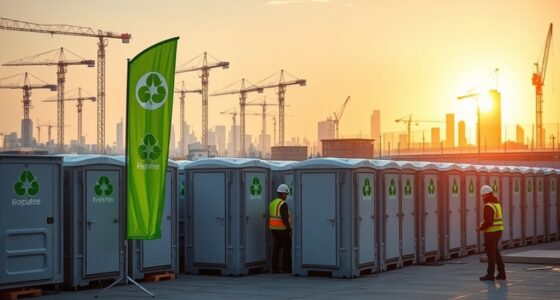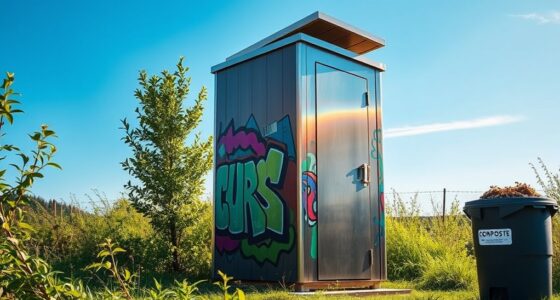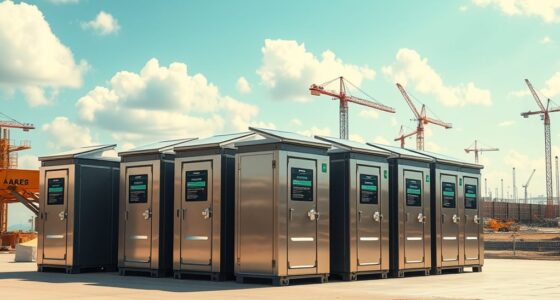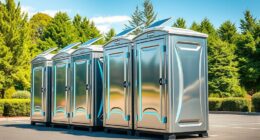IoT-enabled restrooms use real-time sensors to monitor occupancy, cleanliness, and supply levels constantly. This technology helps you keep units cleaner by quickly identifying issues like vandalism, supplies running out, or hygiene concerns. Automated adjustments to lighting, ventilation, and fixtures improve efficiency and user safety while reducing waste. If you want to see how this innovative approach is transforming restroom management, there’s more to discover about these smarter solutions.
Key Takeaways
- IoT sensors enable real-time monitoring of occupancy, cleanliness, and supply levels, ensuring timely maintenance and hygiene.
- Automated data analytics optimize cleaning schedules and resource use, maintaining cleaner restrooms efficiently.
- Sensor-driven automation adjusts lighting, ventilation, and fixtures based on occupancy, enhancing hygiene and energy efficiency.
- IoT security features detect vandalism or unauthorized access, improving safety and vandalism prevention.
- Overall, IoT-enabled restrooms provide cleaner, safer, and more sustainable environments through continuous monitoring and smart management.
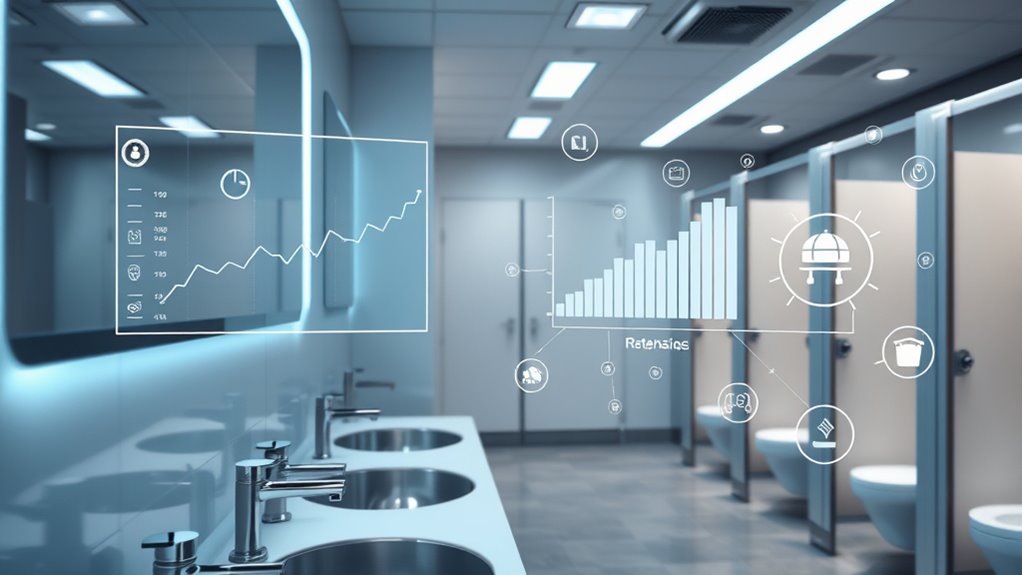
Imagine a restroom that anticipates your needs and operates seamlessly thanks to Internet of Things (IoT) technology. As you step inside, you might not realize that smart sensors are actively working behind the scenes to improve your experience. These sensors continuously monitor various parameters, such as occupancy, water usage, and cleanliness levels, providing real-time data that helps facility managers keep everything running smoothly. With this information, they can promptly address issues like empty soap dispensers or overflowing trash bins before you even notice. The integration of smart sensors into restroom infrastructure allows for proactive maintenance, meaning fewer disruptions and a consistently clean environment for everyone.
Smart sensors in restrooms enable proactive maintenance and seamless operation for a cleaner, more efficient experience.
Data analytics plays a essential role in transforming raw sensor data into actionable insights. By analyzing patterns over time, facility managers can identify peak usage times, optimize cleaning schedules, and reduce waste. For example, if data shows certain restrooms are rarely used during specific hours, cleaning efforts can be adjusted accordingly, saving resources and reducing costs. Conversely, high-traffic periods trigger more frequent servicing, ensuring the facilities stay hygienic and inviting. This intelligent approach not only improves operational efficiency but also enhances user satisfaction, as the restroom remains cleaner and more responsive to your needs.
Furthermore, IoT-enabled restrooms can automatically adjust features like lighting, ventilation, and water flow based on real-time occupancy data. When sensors detect no one is present, lights dim or turn off to conserve energy, and ventilation systems adapt to maintain air quality without wasting power. When someone enters, everything activates seamlessly, creating a comfortable environment without manual intervention. This automation reduces energy consumption and promotes sustainability, making these restrooms environmentally friendly.
Security and hygiene also benefit from IoT technology. Smart sensors can monitor for signs of vandalism or unauthorized access, alerting security personnel immediately. Touchless fixtures, triggered by sensor detection, minimize contact points, reducing the spread of germs—an especially important feature in today’s health-conscious world. Restroom analytics can also monitor supply levels, ensuring soap, paper towels, and toilet paper are always stocked, preventing shortages that could inconvenience users or compromise hygiene standards.
In essence, the rise of IoT-enabled restrooms is transforming how public and private facilities operate. By leveraging smart sensors and data analytics, these restrooms become smarter, cleaner, and more efficient. You benefit from a more comfortable, hygienic environment, while facility managers enjoy streamlined operations and resource savings. It’s a future where technology seamlessly enhances everyday experiences, making restroom visits more convenient, sustainable, and sanitary for everyone.
Frequently Asked Questions
How Secure Is the Data Collected From Iot-Enabled Restrooms?
You might wonder how secure the data from IoT-enabled restrooms is. Rest assured, it’s protected through data encryption, which safeguards information during transmission and storage. Access controls are also in place, ensuring only authorized personnel can view or modify the data. While no system is completely invulnerable, these security measures markedly reduce the risk of breaches, keeping your data safer and more private.
What Is the Cost Comparison Between Traditional and Iot-Enabled Restrooms?
Imagine your budget as a garden—cost analysis helps you decide what to plant. IoT-enabled restrooms often have higher upfront costs due to technology investments but save money long-term through reduced maintenance and water usage. Traditional restrooms may be cheaper initially, but ongoing expenses add up. When budget planning, consider the long-term savings IoT offers, making it a wise investment that nurtures efficiency and cleanliness.
How Do Iot Systems Handle Power Outages or Connectivity Issues?
When power outages or connectivity issues happen, IoT systems rely on built-in power backups like batteries to keep essential functions running. They also use connectivity resilience strategies such as local data storage and multiple network options to maintain communication. This way, you can guarantee continuous monitoring and control, even during disruptions. Regular maintenance of power backup systems and network redundancies helps keep your IoT-enabled restroom operational at all times.
Can Iot-Enabled Restrooms Be Customized for Specific Facility Needs?
You can customize IoT-enabled restrooms to suit your facility’s specific needs. Many systems offer flexible customization options, allowing you to add facility-specific features like tailored alerts, data dashboards, or maintenance schedules. This guarantees the technology aligns with your operational goals, improving efficiency and hygiene standards. By choosing a system that offers these customization options, you can create a more effective and user-centric restroom management solution tailored to your facility.
What Maintenance Is Required for Iot Sensor Devices Over Time?
Think of your IoT sensors as a trusted garden, needing regular care to thrive. You’ll need to calibrate sensors periodically to guarantee accuracy, much like pruning to keep plants healthy. Additionally, don’t forget battery replacements, which keep the system energized and responsive. By tending to these tasks, you ensure your monitoring system stays reliable, providing real-time insights that help maintain cleanliness and efficiency effortlessly over time.
Conclusion
Imagine a restroom that breathes with you, constantly alert and ready to serve at its best. With IoT-enabled monitoring, these spaces transform into vigilant guardians, seamlessly catching dirt and discomfort before you even notice. You don’t just pass through—you experience a cleaner, smarter environment that adapts in real time. This technological symphony turns ordinary restrooms into shining beacons of hygiene, making your comfort feel like a natural part of everyday life.

